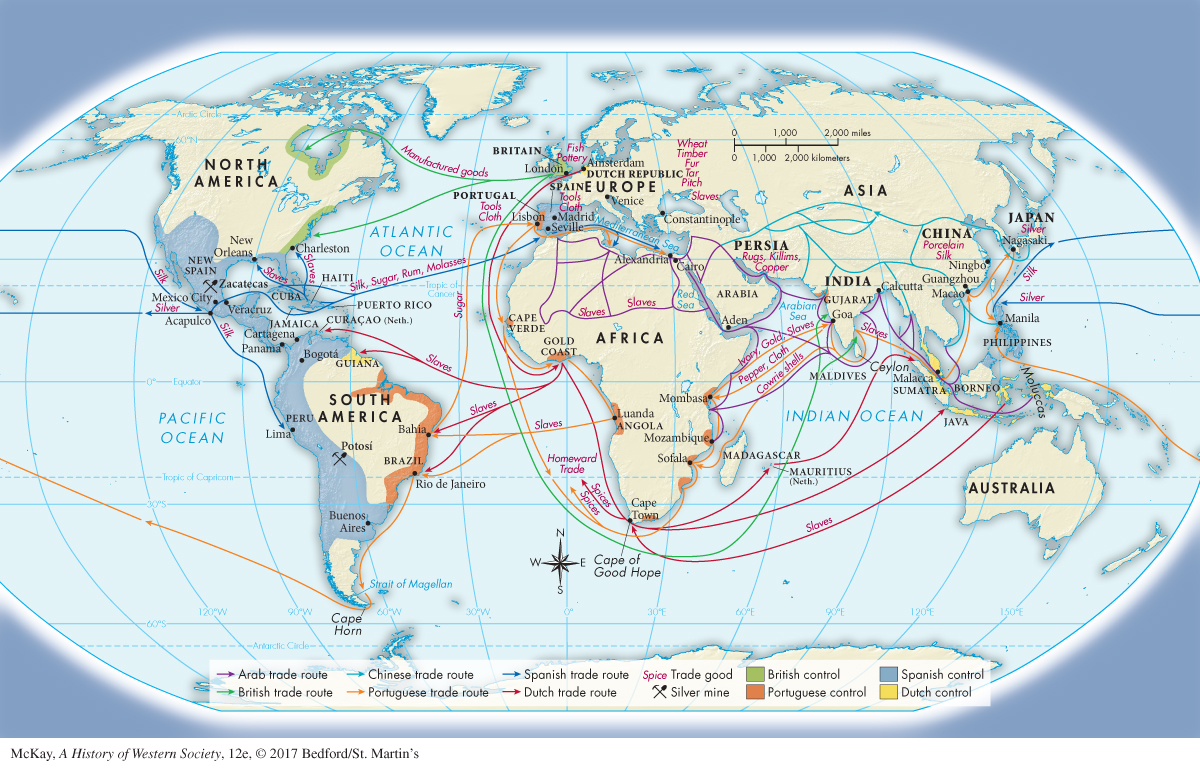A History of Western Society: Printed Page 449
A History of Western Society, Value Edition: Printed Page 435
A History of Western Society, Concise Edition: Printed Page 451
Sugar and Slavery
Two crucial and interrelated elements of the Columbian exchange were the transatlantic trade in sugar and slaves. Throughout the Middle Ages slavery was deeply entrenched in the Mediterranean, but it was not based on race; many slaves were European in origin. How, then, did black African slavery enter the European picture and take root in the Americas? In 1453 the Ottoman capture of Constantinople halted the flow of slaves from the eastern Mediterranean to western Europe. Additionally, the successes of the Iberian reconquista drastically diminished the supply of Muslim captives. Cut off from its traditional sources of slaves, Mediterranean Europe turned to sub-
As Portuguese explorers began their voyages along the western coast of Africa, one of the first commodities they sought was slaves. In 1444 the first ship returned to Lisbon with a cargo of enslaved Africans. While the first slaves were simply seized by small raiding parties, Portuguese merchants soon found that it was easier to trade with local leaders, who were accustomed to dealing in slaves captured through warfare with neighboring powers. In 1483 the Portuguese established an alliance with the kingdom of Kongo. The royal family eventually converted to Christianity, and Portuguese merchants intermarried with Kongolese women, creating a permanent Afro-

In this stage of European expansion, the history of slavery became intertwined with the history of sugar. Originally sugar was an expensive luxury, but population increases and monetary expansion in the fifteenth century led to increasing demand. Native to the South Pacific, sugar was taken in ancient times to India, where farmers learned to preserve cane juice as granules that could be stored and shipped. From there, sugar crops traveled to China and the Mediterranean, where islands like Crete and Sicily had the warm and wet climate needed for growing sugarcane. When Genoese and other Italians colonized the Canary Islands and the Portuguese settled on the Madeira Islands, sugar plantations came to the Atlantic.
Sugar was a particularly difficult crop to produce for profit. Seed-

The transatlantic slave trade began in 1518 when the Spanish emperor Charles V authorized traders to bring enslaved Africans to the Americas. The Portuguese brought the first slaves to Brazil around 1550; by 1600 four thousand were being imported annually. After its founding in 1621, the Dutch West India Company, with the full support of the United Provinces, transported thousands of Africans to Brazil and the Caribbean, mostly to work on sugar plantations. In the mid-
Before 1700, when slavers decided it was better business to improve conditions, some 20 percent of slaves died on the voyage.17 The most common cause of death was from dysentery induced by poor-
In total, scholars estimate that European traders embarked over 12 million enslaved Africans across the Atlantic from 1500 to 1875 (of whom roughly 10.7 million disembarked), with the peak of the trade occurring in the eighteenth century.19 By comparison, only 2 to 2.5 million Europeans migrated to the New World during the same period. Slaves worked in an infinite variety of occupations: as miners, soldiers, sailors, servants, and artisans and in the production of sugar, cotton, rum, indigo, tobacco, wheat, and corn.